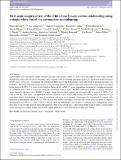Files in this item
First semi-empirical test of the white dwarf mass-radius relationship using a single white dwarf via astrometric microlensing
Item metadata
| dc.contributor.author | McGill, Peter | |
| dc.contributor.author | Anderson, Jay | |
| dc.contributor.author | Casertano, Stefano | |
| dc.contributor.author | Sahu, Kailash C. | |
| dc.contributor.author | Bergeron, Pierre | |
| dc.contributor.author | Blouin, Simon | |
| dc.contributor.author | Dufour, Patrick | |
| dc.contributor.author | Smith, Leigh C. | |
| dc.contributor.author | Evans, N. Wyn | |
| dc.contributor.author | Belokurov, Vasily | |
| dc.contributor.author | Smart, Richard L. | |
| dc.contributor.author | Bellini, Andrea | |
| dc.contributor.author | Calamida, Annalisa | |
| dc.contributor.author | Dominik, Martin | |
| dc.contributor.author | Kains, Noé | |
| dc.contributor.author | Klüter, Jonas | |
| dc.contributor.author | Nielsen, Martin Bo | |
| dc.contributor.author | Wambsganss, Joachim | |
| dc.date.accessioned | 2022-12-09T12:30:11Z | |
| dc.date.available | 2022-12-09T12:30:11Z | |
| dc.date.issued | 2023-03-01 | |
| dc.identifier | 282240091 | |
| dc.identifier | 4e2729e6-1333-47c8-b79d-56a83940a138 | |
| dc.identifier | 85148665885 | |
| dc.identifier.citation | McGill , P , Anderson , J , Casertano , S , Sahu , K C , Bergeron , P , Blouin , S , Dufour , P , Smith , L C , Evans , N W , Belokurov , V , Smart , R L , Bellini , A , Calamida , A , Dominik , M , Kains , N , Klüter , J , Nielsen , M B & Wambsganss , J 2023 , ' First semi-empirical test of the white dwarf mass-radius relationship using a single white dwarf via astrometric microlensing ' , Monthly Notices of the Royal Astronomical Society , vol. 520 , no. 1 , stac3532 , pp. 259–280 . https://doi.org/10.1093/mnras/stac3532 | en |
| dc.identifier.issn | 0035-8711 | |
| dc.identifier.other | BibCode: 2022arXiv220601814M | |
| dc.identifier.other | ORCID: /0000-0002-3202-0343/work/128097772 | |
| dc.identifier.uri | https://hdl.handle.net/10023/26568 | |
| dc.description | Funding: Support for this research was provided by NASA through grants from STScI. HST data used in this paper are available from the Mikulski Archive for Space Telescopes at STScI (https://archive.stsci.edu/hst/search.php) under proposal IDs 15705, 15961 and 16251. PM acknowledges studentship funding support from the United Kingdom Science and Technology Facilities Council (STFC) and the Cambridge Centre for Doctoral Training in Data Intensive Science (CDT-DIS). MBN acknowledges support from the UK Space Agency. This research is based on observations made with the NASA/ESA Hubble Space Telescope obtained from the Space Telescope Science Institute, which is operated by the Association of Universities for Research in Astronomy, Inc., under NASA contract NAS 5–26555. This work presents results from the European Space Agency (ESA) space mission Gaia. Gaia data are being processed by the Gaia Data Processing and Analysis Consortium (DPAC). Funding for the DPAC is provided by national institutions, in particular the institutions participating in the Gaia Multi-Lateral Agreement (MLA). The Gaia mission website is https://www.cosmos.esa.int/gaia. The Gaia Archive website is http://archives.esac.esa.int/gaia. | en |
| dc.description.abstract | In November 2019 the nearby single, isolated DQ-type white dwarf LAWD 37 (WD 1142-645) aligned closely with a distant background source and caused an astrometric microlensing event. Leveraging astrometry from Gaia and followup data from the Hubble Space Telescope we measure the astrometric deflection of the background source and obtain a gravitational mass for LAWD 37. The main challenge of this analysis is in extracting the lensing signal of the faint background source whilst it is buried in the wings of LAWD 37's point spread function. Removal of LAWD 37's point spread function induces a significant amount of correlated noise which we find can mimic the astrometric lensing signal. We find a deflection model including correlated noise caused by the removal of LAWD 37's point spread function best explains the data and yields a mass for LAWD 37 of 0.56 ± 0.08 M ⊙. This mass is in agreement with the theoretical mass-radius relationship and cooling tracks expected for CO core white dwarfs. Furthermore, the mass is consistent with no or trace amounts of hydrogen that is expected for objects with helium-rich atmospheres like LAWD 37. We conclude that further astrometric followup data on the source is likely to improve the inference on LAWD 37's mass at the ≈3 percent level and definitively rule out purely correlated noise explanations of the data. This work provides the first semi-empirical test of the white dwarf mass-radius relationship using a single, isolated white dwarf and supports current model atmospheres of DQ white dwarfs and white dwarf evolutionary theory. | |
| dc.format.extent | 22 | |
| dc.format.extent | 5975573 | |
| dc.format.extent | 3634657 | |
| dc.language.iso | eng | |
| dc.relation.ispartof | Monthly Notices of the Royal Astronomical Society | en |
| dc.subject | Gravitational lensing: micro | en |
| dc.subject | Micro-astronomy | en |
| dc.subject | White dwarfs | en |
| dc.subject | Astrometry | en |
| dc.subject | QB Astronomy | en |
| dc.subject | QC Physics | en |
| dc.subject | 3rd-DAS | en |
| dc.subject | MCC | en |
| dc.subject.lcc | QB | en |
| dc.subject.lcc | QC | en |
| dc.title | First semi-empirical test of the white dwarf mass-radius relationship using a single white dwarf via astrometric microlensing | en |
| dc.type | Journal article | en |
| dc.contributor.institution | University of St Andrews. School of Physics and Astronomy | en |
| dc.contributor.institution | University of St Andrews. St Andrews Centre for Exoplanet Science | en |
| dc.identifier.doi | 10.1093/mnras/stac3532 | |
| dc.description.status | Peer reviewed | en |
| dc.identifier.url | http://adsabs.harvard.edu/abs/2022arXiv220601814M | en |
This item appears in the following Collection(s)
Items in the St Andrews Research Repository are protected by copyright, with all rights reserved, unless otherwise indicated.

